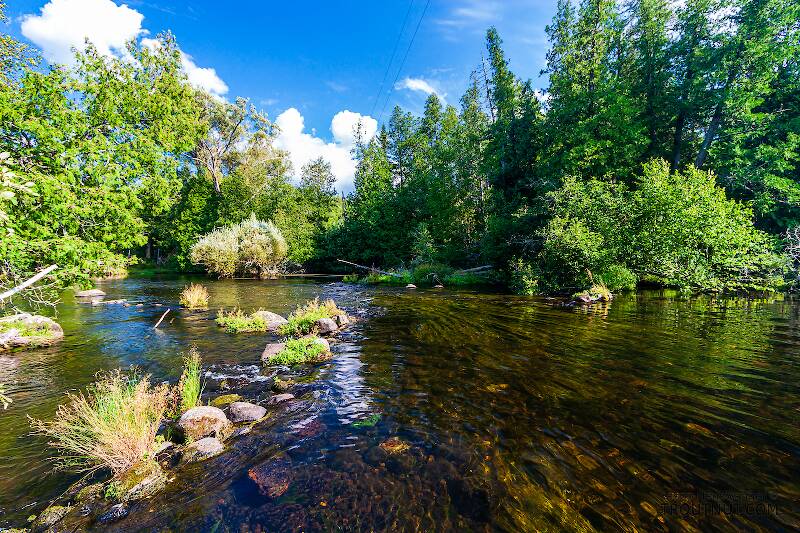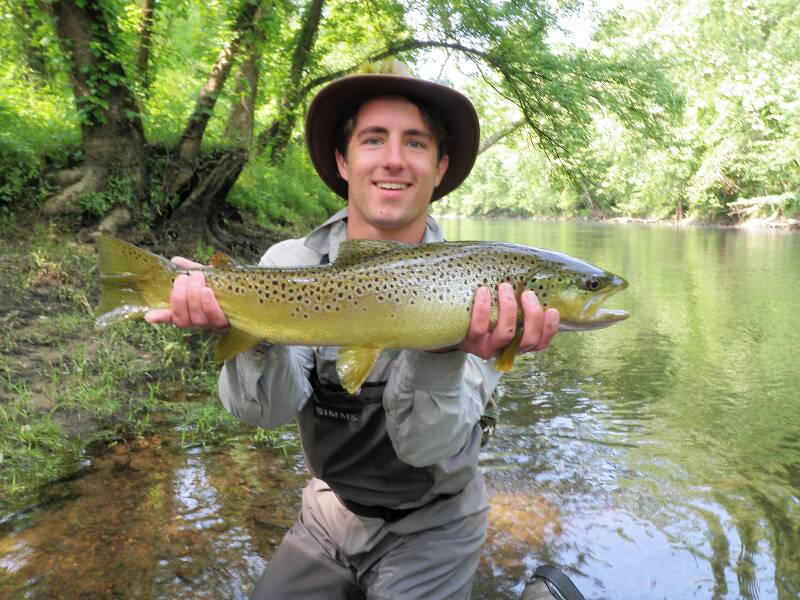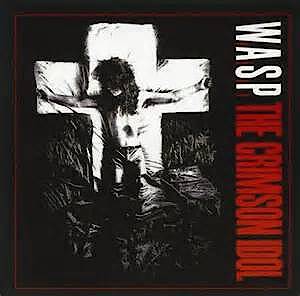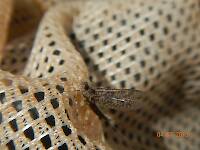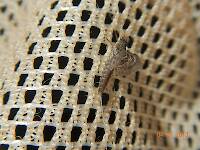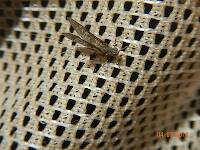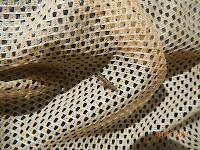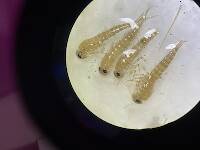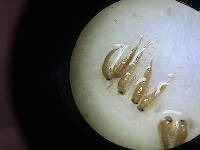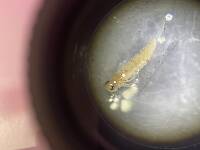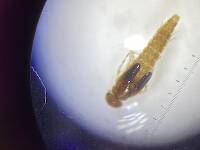
Salmonflies
Pteronarcys californica
The giant Salmonflies of the Western mountains are legendary for their proclivity to elicit consistent dry-fly action and ferocious strikes.
Featured on the forum

Troutnut is a project started in 2003 by salmonid ecologist Jason "Troutnut" Neuswanger to help anglers and
fly tyers unabashedly embrace the entomological side of the sport. Learn more about Troutnut or
support the project for an enhanced experience here.
Jesse on Jul 9, 2011July 9th, 2011, 10:31 pm EDT
Whats the easiest way to tell the difference between mayfly duns and spinners? I damn hate when i get confused or question myself about them!
Most of us fish our whole lives..not knowing its not the fish that we are after.
http://www.filingoflyfishing.com
http://www.filingoflyfishing.com
Martinlf on Jul 9, 2011July 9th, 2011, 10:52 pm EDT
Spinners often have clearer wings, thinner darker bodies, and longer tails than duns of the same species. Duns are typically (but not always) best represented by upright wings--spinners with wings parallel to the water's surface.
"He spread them a yard and a half. 'And every one that got away is this big.'"
--Fred Chappell
--Fred Chappell
GONZO on Jul 9, 2011July 9th, 2011, 11:28 pm EDT
Cloudy, somewhat opaque wings vs. shiny, mostly clear wings is a good general rule of thumb, Jess (though there are exceptions to that guideline). In most species, you can tell the difference at a glance; others will require a closer look. Some species have pigmented wings in the spinner stage, but the (usually) big-eyed males will typically have much longer forelegs and tails in the spinner stage. When in doubt, you could use magnification to try to see the fringe of tiny hairs found along the edge of the wings of duns.
There are also some species that don't have a spinner stage in the females, some (females) that become "pharate" adults (apolysis, but no ecdysis), some that only do a partial molt, and even a few that retain some characteristics of a dun in the spinner stage, but these are the rare exceptions rather than the rule.
There are also some species that don't have a spinner stage in the females, some (females) that become "pharate" adults (apolysis, but no ecdysis), some that only do a partial molt, and even a few that retain some characteristics of a dun in the spinner stage, but these are the rare exceptions rather than the rule.
Martinlf on Jul 10, 2011July 10th, 2011, 9:15 am EDT
I was hoping Gonzo would add more detail. One of the exceptions on the body color would of course be Eastern Green Drakes, where the spinners have a whitish abdomen vs. the darker abdomen of the dun. The GD thorax is darker, though. And as Gonzo noted there are exceptions to the general descriptions I suggested.
"He spread them a yard and a half. 'And every one that got away is this big.'"
--Fred Chappell
--Fred Chappell
Konchu on Jul 10, 2011July 10th, 2011, 11:18 am EDT
When I'm in the field, I check for a general dullness, and sometimes a milkiness about the wings and body to recognize the duns. The spinners have a crispness and shininess about them.
Entoman on Jul 10, 2011July 10th, 2011, 11:28 am EDT
Hi Jesse,
Another way you can tell the difference is by behavior. Duns come off the water and rise slowly into the air, usually flying off into the distance without hanging around. Spinners are usually seen flying in groups above the water, also usually hovering and "dancing".
Kurt
Another way you can tell the difference is by behavior. Duns come off the water and rise slowly into the air, usually flying off into the distance without hanging around. Spinners are usually seen flying in groups above the water, also usually hovering and "dancing".
Kurt
"It's not that I find fishing so important, it's just that I find all other endeavors of Man equally unimportant... And not nearly as much fun!" Robert Traver, Anatomy of a Fisherman
Jesse on Jul 12, 2011July 12th, 2011, 10:37 pm EDT
Good stuff guys thanks. Also, does it have anything to do with the difference in two and three tail fibers?
Most of us fish our whole lives..not knowing its not the fish that we are after.
http://www.filingoflyfishing.com
http://www.filingoflyfishing.com
Taxon on Jul 12, 2011July 12th, 2011, 11:40 pm EDT
Jesse-
No, the duns with two tails also have two tails as spinners, and the duns with three tails also have three tails as spinners.
No, the duns with two tails also have two tails as spinners, and the duns with three tails also have three tails as spinners.
Adirman on Jul 13, 2011July 13th, 2011, 2:28 am EDT
I know this is more difficult but, say you only get a fleeting glimpse of several and you know they're mayflies but not sure of species and/or life cycle. Would it be fair to say that duns are a little more colorful looking because the wings will have more color than the spinners?
PaulRoberts on Jul 13, 2011July 13th, 2011, 5:19 am EDT
The Delaware will get you asking questions like this. Whereas on a smaller less productive water one could not bother to ask and still have fun. Doesn't mean it doesn't matter, just it's not so painfully apparent.
Duns tend to fly slowly up and away from the stream looking for cover before they get snarfed. I think that spinners are less apt to fly until they are ready to do their mating dance -where that is and how it looks varies with species. Duns have more noticeable wings, being "cloudy". Spinners, unless backlit tend to show more body and tails. Spinner bodies are usually darker than dun bodies of the same species.
But unless I get a good look, or can ID from a distance, glimpsing a bug rarely changes my game plan. Each bug has specifics to habitat, behavior, and density that make them vulnerable to trout. So I gotta know WHICH bug, then how many their might be; Enough to offer a fishing opportunity?
I know this is more difficult but, say you only get a fleeting glimpse of several and you know they're mayflies but not sure of species and/or life cycle. Would it be fair to say that duns are a little more colorful looking because the wings will have more color than the spinners?
Duns tend to fly slowly up and away from the stream looking for cover before they get snarfed. I think that spinners are less apt to fly until they are ready to do their mating dance -where that is and how it looks varies with species. Duns have more noticeable wings, being "cloudy". Spinners, unless backlit tend to show more body and tails. Spinner bodies are usually darker than dun bodies of the same species.
But unless I get a good look, or can ID from a distance, glimpsing a bug rarely changes my game plan. Each bug has specifics to habitat, behavior, and density that make them vulnerable to trout. So I gotta know WHICH bug, then how many their might be; Enough to offer a fishing opportunity?
Oldredbarn on Jul 13, 2011July 13th, 2011, 8:06 am EDT
So I gotta know WHICH bug, then how many their might be; Enough to offer a fishing opportunity?
Adirman,
I agree here with what I think Paul is saying...If you have bugs flying around you need to just stop fishing and grab one...On the other hand, if you are catching fish, why stop?
I'm one of those anglers that tends to stay late and I love it when there are spinners about. But...We joke about these spinners we seem to see all damn day on the Au Sable in late May that the guides jokingly call "the never falls". They always seem to be dancing at about head level and never seem to make it to the water.
Now we know that this can't be the case since we know that these critters have only so much energy stored and can't really be playing around up there indefinitely.
I think that once the season gets going the fish see spinners of all sorts all day long. Know your stream and its hatches and tie up some different sizes to match your local bugs and try them out as a searching pattern when something else isn't going on. The guides on the Au Sable like to say, "When in doubt tie on a Borcher's", and what they mean is the parachute version...It's "close enough" to match the "drakes" and if you can cast it well, it will get noticed.
Massive spinner falls are mind blowing if you are lucky enough to be there when they "fall"...But the so called "perfect" conditions don't always exist on a stream and the bugs have to go as they say...They are on a timer so-to-speak and they can't wait around being picky. These bugs are programmed to reproduce, not sit around playing cribbage waiting for the weather to change...
I have been on a stream in near gale force winds and as soon as there was a slight lull in the breeze I would see spinners above a riffle. If they dallied and the wind picked back up it would blow them off somewhere.
I think both you and Jess need to take some looks at Jason's photos here. He has many examples of the dun and spinner of different species. Wonderful photos you can take your time looking at and study without standing knee deep in a stream somewhere maybe on a rainy day trying to grab the real thing.
As others have said the spinners tend to return to the stream, after their final moult, with clear wings...Hyaline is a term I've seen used to discribe them...Like celophane...Except for the exceptions that Gonzo mentioned they tend to be clear and some like the March Browns & the Brown Drakes for example carry over some blotchy segments of color in their wings, but for the most part the major portion of the wing is clear...
Their bodies tend to darken...It's almost like they are drying up if you will...They are dying after all or at least running on borrowed time...The most important parts, the reproductive organs, are happening, but the rest of the bug is about to shut down.
If you are lucky enough to get a mating swarm of males above your head nab one if you can...They are pretty good fliers and can be allusive, or stop and watch the swarm and if you don't see any females hooking up and there are no fish feeding consider it a bachelors party and move on...Tuck it in the back of your brain somewhere because they may get it done later before you head back to the car...Spinners can get your blood flowing but they do no good in the air...Fish have a difficult time getting to them up there. :)
All those big attractor flies Jess & Jonathan like to toss will catch you fish no-doubt, just look at their fish pictures, but if you find yourself in a massive spinner fall and the fish are on them and are ignoring the hatching duns...Good luck! There is nothing more maddening than standing in a river after dark and there are fish feeding absolutely everywhere and they don't give a shit about what you are offering them! Oh! While this is all going on you are also getting mauled by all those lovely biting bugs we were discussing on another thread...
"Be prepared! That's the boyscouts marching song..."
Spence
Check out the "Update to Site 07 13 2011 and check out the photos of that Baetis...The dun's wing is opaque and the spinner's you can practically see through.
"Even when my best efforts fail it's a satisfying challenge, and that, after all, is the essence of fly fishing." -Chauncy Lively
"Envy not the man who lives beside the river, but the man the river flows through." Joseph T Heywood
"Envy not the man who lives beside the river, but the man the river flows through." Joseph T Heywood
Konchu on Jul 13, 2011July 13th, 2011, 3:47 pm EDT
there are some mayflies with the dun wings much more colorful than the spinners or even with patterns of dark spots that are not present on the spinners. some ephemerellids and siphlonurids are this way, possibly some baetisca.
Entoman on Jul 13, 2011July 13th, 2011, 4:28 pm EDT
Some heptagenids too.
"It's not that I find fishing so important, it's just that I find all other endeavors of Man equally unimportant... And not nearly as much fun!" Robert Traver, Anatomy of a Fisherman
Jesse on Jul 14, 2011July 14th, 2011, 7:03 pm EDT
The ole clear wing spinner a! Got the suckers down now.
Most of us fish our whole lives..not knowing its not the fish that we are after.
http://www.filingoflyfishing.com
http://www.filingoflyfishing.com
Troutnut on Jul 14, 2011July 14th, 2011, 10:37 pm EDT
there are some mayflies with the dun wings much more colorful than the spinners or even with patterns of dark spots that are not present on the spinners. some ephemerellids and siphlonurids are this way, possibly some baetisca.
Definitely some Baetsica... check out my Baetisca laurentina pictures. I don't have any pictures of obesa spinners, but the duns have similar black mottling.
Jason Neuswanger, Ph.D.
Troutnut and salmonid ecologist
Troutnut and salmonid ecologist
Sayfu
Posts: 560
Posts: 560
Sayfu on Aug 18, 2011August 18th, 2011, 4:36 am EDT
Not all spinners have their wings parallel to the surface...many have their wings flopped over on one side, and tiers will tie the spent wings that way. I had a great chance to observe spinners this year. We had a long, and strong hatch of Grey Drakes, and the effective stage of the Grey Drake is the spinner fall...(siphlinorus sp?) The fly that worked very well was a Parachute Adams in a #14-#12 Parachutes can work well as a spinner.
Quick Reply
Related Discussions
Topic
Replies
Last Reply
1
Sep 9, 2008
by GONZO
by GONZO
4
May 24, 2008
by Softhackle
by Softhackle
0
May 3, 2007
by Troutnut
by Troutnut

